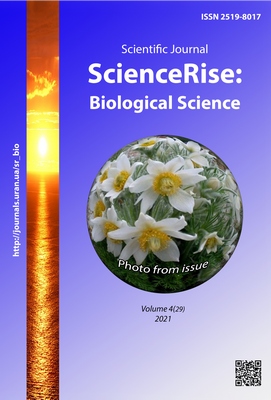Дослідження ефективності використання біогенних металів для годівлі телят
DOI:
https://doi.org/10.15587/2519-8025.2021.249859Ключові слова:
телята, нікотинати біогенних металів, неорганічні речовини, біохімічні показники кровіАнотація
Вирощування молодняка великої рогатої худоби має важливе значення, особливо у перехідний період з молочної годівлі на концентровані сухі корми. В роботі наведено результати застосування нікотинатів біогенних металів для телят на відлученні для покращення метаболізму у тварин.
Мета дослідження. Дослідити вплив нікотинатів біогенних металів: Zn, Cu, Fe, Co, Mn на біохімічні показники крові у телят після відлучення.
Матеріали та методи. Дослідження проводили протягом 2021 року в умовах ТОВ «Агрофірма Лан», Сумська обл., Сумський р-н., с. Кіндратівка, Україна з вирощування великої рогатої худоби. Телятам дослідної групи задавали комбікорм та премікс нікотинатів біогенних металів: Zn, Cu, Fe, Co, Mn, виготовленої ПП «Кронос Агро» (1 г на 1 кг корму). В контрольній групі застосовували комбікорм та премікс з сульфатами металів протягом 30 діб.
Результати. Встановлено, збільшення рівня загального білка в організмі телят дослідних груп на 16,12%, порівняно до контролю (р≤0,05). Також у дослідних тварин активність ферментів аланінамінотрансфераза та аспартатамінотрансфераза була більше фізіологічної норми, що показує незначний вплив нікотинатів біогенних металів на внутрішні органи і системи. У дослідній групі телят рівень магнію був вірогідно вищій на 52,38% та калію – на 14,94%, порівняно до контрольної (р≤0,05). Встановлено, що у тварин дослідних груп вірогідно було більше цинку на 34,96%; міді – на 35,72%; заліза на 92,29%; мангану – на 41,13%; селену – на 3,22% та кобальту – на 98,33%, порівняно до контролю (р≤0,05).
Висновки. Доведений позитивний ефект від застосування нікотинатів біогенних металів на метаболізм телят на відлученні. Встановлено, що рівень загального білка в організмі телят дослідних груп був вірогідно вищій на 16,12%, магнію – на 52,38%; калію – на 14,94%. При визначенні вмісту неорганічних речовин встановлено, що у тварин дослідних груп вірогідно було більше цинку на 34,96%; міді – на 35,72%; заліза на 92,29%; мангану – на 41,13%; селену – на 3,22% та кобальту – на 98,33%, порівняно до контролю (р≤0,05)
Посилання
- Shkromada, O., Dudchenko, Y., Udovenko, Y. (2021). Use of probiotics for formation of microflora of gastrointestinal tract of calves. EUREKA: Health Sciences, 4, 94–100. doi: http://doi.org/10.21303/2504-5679.2021.001951
- Erickson, P. S., Kalscheur, K. F. (2020). Nutrition and feeding of dairy cattle. Animal Agriculture. Elsevier Inc., 157–180. doi: http://doi.org/10.1016/b978-0-12-817052-6.00009-4
- Davis Rincker, L. E., VandeHaar, M. J., Wolf, C. A., Liesman, J. S., Chapin, L. T., Weber Nielsen, M. S. (2011). Effect of intensified feeding of heifer calves on growth, pubertal age, calving age, milk yield, and economics. Journal of Dairy Science, 94 (7), 3554–3567. doi: http://doi.org/10.3168/jds.2010-3923
- Van Amburgh, M. E., Soberon, F., Meyer, M. J., Molano, R. A. (2019). Integration of postweaning nutrient requirements and supply with composition of growth and mammary development in modern dairy heifers. Journal of Dairy Science, 102 (4), 3692–3705. doi: http://doi.org/10.3168/jds.2018-15270
- Ding, J., Shi, M., Wang, L., Qi, D., Tao, Z., Hayat, M. A. et. al. (2020). Gene Expression of Metalloproteinases and Endogenous Inhibitors in the Lamellae of Dairy Heifers With Oligofructose-Induced Laminitis. Frontiers in Veterinary Science, 7. doi: http://doi.org/10.3389/fvets.2020.597827
- Fotina, T., Fotina, H., Nazarenko, S., Tymoshenko, R., Fotin, O. (2021). Effect of feeding of chelated zinc form on security, productivity and slaughter parameters of broilers. EUREKA: Health Sciences, 3, 110–118. doi: http://doi.org/10.21303/2504-5679.2021.001856
- Tomlinson, D. J., Mülling, C. H., Fakler, T. M. (2004). Invited Review: Formation of Keratins in the Bovine Claw: Roles of Hormones, Minerals, and Vitamins in Functional Claw Integrity. Journal of Dairy Science, 87 (4), 797–809. doi: http://doi.org/10.3168/jds.s0022-0302(04)73223-3
- Varagka, N., Lisgara, M., Skampardonis, V., Psychas, V., Leontides, L. (2016). Partial substitution, with their chelated complexes, of the inorganic zinc, copper and manganese in sow diets reduced the laminitic lesions in the claws and improved the morphometric characteristics of the hoof horn of sows from three Greek herds. Porcine Health Management, 2 (1). doi: http://doi.org/10.1186/s40813-016-0040-3
- Vlizlo, V. V. (2012) Laboratorni metody doslidzhen u biolohii, tvarynnytstvi ta veterynarnii medytsyni. Lviv: SPOLOM, 764.
- Miles, R. D., Henry, P. R. (2006). Relative trace mineral bioavailability. Ciência Animal Brasileira, 1 (2), 73–93. Available at: https://www.revistas.ufg.br/vet/article/view/252
- Mantovani, A. (2017). Safety and efficacy of zinc chelate of methionine sulfate for all animal species. EFSA journal. European Food Safety Authority, 15 (6). doi: http://doi.org/10.2903/j.efsa.2017.4859
- Andrieu, S. (2008). Is there a role for organic trace element supplements in transition cow health? The Veterinary Journal, 176 (1), 77–83. doi: http://doi.org/10.1016/j.tvjl.2007.12.022
##submission.downloads##
Опубліковано
Як цитувати
Номер
Розділ
Ліцензія
Авторське право (c) 2021 Oksana Shkromada, Tatiana Fotina, Roman Petrov

Ця робота ліцензується відповідно до Creative Commons Attribution 4.0 International License.
Наше видання використовує положення про авторські права Creative Commons CC BY для журналів відкритого доступу.
Автори, які публікуються у цьому журналі, погоджуються з наступними умовами:
1. Автори залишають за собою право на авторство своєї роботи та передають журналу право першої публікації цієї роботи на умовах ліцензії Creative Commons CC BY, котра дозволяє іншим особам вільно розповсюджувати опубліковану роботу з обов'язковим посиланням на авторів оригінальної роботи та першу публікацію роботи у цьому журналі.
2. Автори мають право укладати самостійні додаткові угоди щодо неексклюзивного розповсюдження роботи у тому вигляді, в якому вона була опублікована цим журналом (наприклад, розміщувати роботу в електронному сховищі установи або публікувати у складі монографії), за умови збереження посилання на першу публікацію роботи у цьому журналі.










